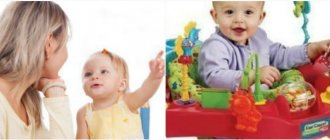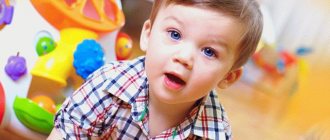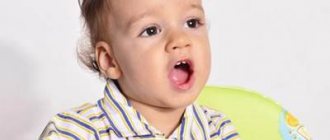Most often, healthy children pronounce their first words at about one year of age. If this does not happen, many parents begin to sound the alarm. However, experts in the field of early development have concluded that the initiation of speech is an individual process for which there is no clear age period. Studies of speech development show that the appearance of speech in a child depends both on the maturation of certain parts of the brain and on the environment in which the child grows. Knowing the characteristics of their child, parents can create a favorable environment for him and help overcome difficulties in the development of your baby's speech.
Early childhood and speech development
Early age (from birth to 3 years) is a special period in a child’s life. In terms of the intensity of development and the complexity of the tasks solved at this stage, the first years of life have no equal. This is also the most favorable period for mastering the basics of your native speech. What gets missed now may require double effort later!
Would it surprise you if we told you that a child's speech abilities begin to develop even before he is born? And this is exactly so. Let's find out what actually affects the development of speech in a baby.
What factors influence speech development
- Biological: heredity; correct structure and functioning of the central nervous system, speech centers in the brain, hearing and speech organs; healthy pregnancy and successful birth; healthy physical and mental development after birth.
- Social: a full-fledged speech environment from the first days of a child’s life, a favorable developmental environment.
Health of a one-year-old child
A visit to the pediatrician every year is considered a mandatory procedure. The doctor takes the necessary tests from the child and makes physiological measurements. The issue of child vaccination is also being addressed. It is also necessary to visit the following specialists: neurologist, surgeon, orthopedist. Additionally, it is advisable to consult an ophthalmologist and dentist.
An important component of a healthy lifestyle is maintaining the child’s personal hygiene. At one year of age, a baby can learn to wash his hands before eating and after a walk, as well as wash himself. If a child has grown at least 1 tooth, it is worth making friends with a toothbrush. And, of course, do not ignore evening bathing and rinsing in the shower.
How a child’s speech is formed from birth to 3 years
The baby learns to communicate with the outside world from the very moment of birth. Let's take a look at how the speech development of young children proceeds during the first 3 years of a child's life. Norms of speech development in children from 0 to 3 years
- 0 – 2 months. Scream. The first form of communication for a child is crying. The baby cries when he is hungry, uncomfortable or tired.
- 2 – 3 months. Booming. Crying is replaced by cheering. The sounds “a”, “s”, “u” appear, sometimes in combination with “g”. The child learns to understand speech addressed to him and control his own sound intonations.
- 3 – 6 months. Babble. The baby begins to babble to himself and make sounds when addressed to him. Turns his head towards the sound. Freezes in response to a sudden loud sound. Cries differently depending on needs: “I’m hungry,” “I’m tired.” Recognizes his name and reacts to it.
- 6 months. First syllables. From the age of 6 months, you can notice that the child prefers strictly certain sounds to all others: “ba”, “ma” (they are the easiest to learn to pronounce). He can repeat them endlessly: he likes the way they sound.
- 7 – 9 months. Combinations of syllables. The babbling progresses to the utterance of identical syllables: “ma-ma-ma”, “dya-dya-dya”, “ba-ba-ba”.
- 9 – 11 months. Onomatopoeia. The baby imitates the sounds of adults' speech. Responds to name. Understands the meaning of the word “no.”
- 11 – 13 months. The first meaningful words from two identical syllables: “dad”, “mom”, “baba”, “uncle”. 12 months. The baby shows interest and attention to the speech of others, repeats and combines sounds in a new way, combines them into “words”, imitating the speech of an adult. Understands and follows simple one-word instructions (“sit down”). He waves his hand “bye-bye”, shakes his head “no”. Uses gestures and sounds to attract attention. Interested in books.
Rarely does a parent know what signs indicate deviations in the child’s development. Therefore, for prevention, be sure to visit a pediatric neurologist at 3, 6, 9 and 12 months.
- 18 months. The baby easily repeats frequently heard words. Knows different parts of the body and points to them. Masters simple words (by the age of 2 years, their vocabulary can range from 20 to 50). Answers in words or gestures the questions: “Where is the bear?”, “What is this?” He loves when people read to him. At the request of an adult, he points his finger at the pictures in the book. 2 years. First sentences (two words). A two-year-old child can easily combine simple words mastered by the age of 2 into combinations: “Mom, give me,” “I want this,” “Where is the kitty?” Understands simple instructions consisting of two sequential actions: “Find your teddy bear and show it to grandma.” The vocabulary can expand to 150 - 200 lexemes, and others can already understand half of the words the child pronounces. The baby begins to use pronouns, adjectives and prepositions. Holds a book correctly in his hands. “Reads” to his toys.
- 3 years. Multi-word sentences (three or more words). At 3 years old, the period of early childhood ends. By this turning point, the child is able to compose sentences of three or more words. Distinguishes between colors and size definitions. Remembers and repeats familiar rhythms, melodies, stories. Some difficulties in sound pronunciation may still persist (whistling, hissing, vowel sounds). The vocabulary is expanding so much that parents can no longer accurately count how many words it consists of. In general, the baby is already ready to speak out on any occasion.
Who is faster: boys or girls
Of course, each baby is unique and develops at its own pace. In practice, a slight delay in speech development may turn out to be only an individual feature. Moreover, the rate of speech development can be affected by: illness, stress, lack of communication with surrounding adults, or the multilingual environment in which the baby grows up.
And it can still be very difficult to resist the temptation to compare your child with others. Why do some children at the age of 2 already read passages from “Moidodyr” from memory and speak in whole phrases, while others need another 1.5 - 2 years to be at the same level? Should I be worried about this?
In modern psychology, two types of children with normally developing speech are distinguished: “talkers” and “silent ones.”
- “Talkers” show increased activity and interest in the world around them. Such children love to tell stories, ask a lot of questions and easily get accustomed to new surroundings. Sometimes they start talking earlier than other children.
- “Silent people” tend to be contemplative. They always need to adapt to new surroundings. They may start speaking late, but almost immediately without defects. It is important for such kids to be heard and understood. Therefore, parents should try to respond carefully to the child’s questions. However, if the “silent child” has not begun to speak by the age of 2–3 years, you need to contact a specialist.
According to statistics, boys begin to develop speech later than girls. One of the reasons lies in physiology. Brain maturation occurs faster in girls. This affects the growth of vocabulary: by the age of 2, girls usually have twice as much vocabulary as boys of the same age. Plus, they are more emotional by nature and happily share all their impressions, while boys tend to show greater verbal restraint, speaking only “to the point.”
In addition, numerous studies have shown that the higher the child’s motor activity, the better speech development. It makes sense that more active kids might begin to demonstrate advanced language skills before their slower peers.
Playing with a child promotes speech development. Encourage him to move more, and the baby will happily pick up the game.
"Y?"
During this same period, children are very fond of pointing with their finger at an object that interests them with the question word “Y?”. Parents are often annoyed by this; they believe that it is indecent to behave this way. But such a gesture is very important for speech development! Do not forbid doing this under any circumstances, and, moreover, help the baby master such a gesture if necessary.
The famous Russian psychologist L. S. Vygotsky believed that the pointing gesture was originally simply a failed or unfinished grasping movement. “The child is trying to grab an object that is too far away; his hands, extended to the object, remain hanging in the air... There is a movement here that objectively points to the object, and nothing more. But when the mother comes to the child’s aid and interprets his movement as an instruction, the situation changes significantly. The pointing gesture becomes a gesture for others.”
Thus, the baby makes an amazing discovery: everything around has its own name - everyone, every object! "Y?" with a pointing gesture is a greedy question: “What is this?” This is a cat, and this is a house, and this is a big dump truck... Passive vocabulary (i.e. words that a child understands, but cannot reproduce himself) is becoming richer each time, and someday it will certainly turn from passive into active (active vocabulary is the words that the child pronounces).
How to help the speech development of young children
What can we, parents, do from the very birth of a child to ensure that he speaks naturally?
Let us remind you that the sensory channel for perceiving information about the external environment (vision, hearing, taste, smell and touch) is the main one for children in the first years of life. Therefore, the answer lies on the surface: it is necessary to give the child as much information as possible about the world around him, as much as possible of any kind of sensory sensations and stimuli. Let's talk about it.
- Touch. Feeling #1 at first. Mother's warm hands, her gentle touches, stroking, massage, gymnastics, toys of different shapes and textures, finger games - the more of this, the better. Knowledge about oneself, one’s body and its sensations is formed through contact with the environment, so diversify the child’s tactile sensations as much as possible. Water of different temperatures (carefully!), soft fabric and rubber balls, a plastic rattle and a wooden cube, finger paints on a palette, sand in a children's sandbox, beans in a jar, etc. - the world is so rich for training your sense of touch!
- Hearing. Give your baby as much information as possible that he can perceive by ear: the sounds of music, nature, household appliances in the house, street noise from the window and, of course, the sounds of his native speech. Always talk to your baby about everything. Mom does this naturally, because speech accompanies any of her actions: she voices swaddling, feeding, bathing, and putting her to bed. She names objects surrounding the child, pointing at them. When the baby starts to walk, the mother “keeps up the conversation”: she responds to the sounds the baby makes, repeats them and introduces him to adult speech, which the baby will try to imitate as he grows up.
- Vision. We interest the baby in the objects around him so that he learns to focus his vision and maintain his attention on significant objects. To help your child concentrate, you can hang bright colored objects above the crib (for example, balloons, fluffy pom-poms - they are quite light and will certainly attract attention). Some mobile models come with removable toys to help adults provide a stimulating and varied space for their child. This is for the little ones. Later, the arsenal of objects from the surrounding reality can be replenished endlessly, both due to toys in the house, and due to the visual impressions that the baby will receive when he is outside the home: on a city street, on a river, in a forest, in a zoo.
- Taste. Mother's milk, water, teas, juices, pureed and solid food - what a variety of textures and tastes! Introduce your baby to them by gradually expanding the range of products that you introduce into baby food. The sooner a child becomes familiar with basic tastes, the less picky he will be in food later.
When the time comes for the first complementary foods, for example from the “Agusha First Spoon” line, it is important to name the products that the mother offers the baby. Cottage cheese, kefir, juice, fruit puree - this is an opportunity to introduce your child to the names of fruits, vegetables, and talk about animals. For example, about a cow that gives milk, he says “mu” and grazes in the meadow.
- Smell. Getting to know smells not only enriches the perception of the overall picture of the world, but also creates a certain mood, associations and subsequently pleasant memories in the baby. The smell of freshly baked bread and grandma’s jam, autumn leaves and spring melting snow, mushrooms and wildflowers - so many memories behind each of them! Don’t forget about this side of perception, learn smells together with your child, teach him to distinguish them and compare them - what if you have a future perfumer growing up?
- Gross motor skills (movements of large muscles: body, arms, legs). It is important to motivate your baby to move actively from the first weeks of life. If you think your baby needs to be swaddled, be sure to allow enough time for your baby to move his arms and legs freely. As your baby gets older, create a safe space for free movement in the house.
- Fine motor skills (fine movements of the hands and fingers). Only a newborn has never heard of the fact that fine motor skills and speech are connected. This connection is explained by the proximity of the speech motor and movement centers in the brain. Therefore, any activity aimed at stimulating fine motor skills has a positive effect on speech formation. And don’t forget about developing self-care skills from early childhood: a cup, a toothbrush, cutlery, buttons on clothes, zippers and shoelaces are great exercise equipment!
Speech is a product of the work of the muscles and organs of the speech apparatus, and, as in the case of training any other muscle, speech must be developed through consistent and regular exercise. Let's talk about these classes and about the exercises that need to be included in the child's daily “speech exercises”.
Nimble fingers
Training fine finger movements has a great influence on the development of a child’s active speech. This phenomenon has long been known to psychologists and speech therapists. And they never tire of repeating how important it is to develop fine motor skills. A variety of finger games, manipulations with paper (it can be torn into small pieces, crumpled, crumpled), and unscrewing and tightening the lids on cans and bottles will help with this.
As always, an inexhaustible resource in this regard is an ordinary kitchen. My child, for example, really liked hiding small toys from Kinder Surprises in a bowl of dry peas or lentils, and then finding them by touch (be careful, Kinder Surprises often contain small parts that, of course, should not be given to the baby). The peas gently massage little fingers, and the baby receives many pleasant tactile sensations. Try it yourself!
You can draw with your fingers on a tray on which a thin layer of flour or semolina is sprinkled. You can play with cotton swabs, taking them out of the jar one at a time and then putting them back in. You can attach colorful clothespins to a plastic jar or box, and then unhook them and throw them into the same jar.
Look around, and perhaps you will find a new interesting and useful activity for your little one.
How to formulate speech correctly
- Respond to the baby's humming and babbling, imitate his sounds, repeat them.
- Talk to your baby when you are caring for him: swaddling him, feeding him, bathing him. Talk to him throughout the day.
- Read bright, colorful books every day.
- Repeat short rhythmic poems and nursery rhymes.
- Teach your child the names of loved ones and the names of all the objects around him.
- Take your baby with you to new places, be with him in different situations.
- Draw the child's attention to various objects that make sounds (animals, birds, vehicles, etc.).
- Encourage your child to try to pronounce new words.
- “Talk” with your child new situations in which he finds himself, before, during and after the event.
- Look at the baby when you talk to him.
- Describe in detail and colorfully to your child what he hears, sees, does and feels.
- Play children's songs and fairy tales for your baby.
- When talking with your little interlocutor, do not imitate children's pronunciation; make sure that your speech is clear, expressive (but without babying), competent, simple and clear.
- Praise your child every time he initiates communication with you.
- Make sure that your child does not use sound pronunciations to indicate surrounding objects. Parents can use simplified forms of the words “give”, “am-am”, “tu-tu” when communicating with a child under one year old. This will help him get involved in the process of speech development. Then it is advisable to accompany the simplified words with the correct names. He saw the train: “Tut-tut!” - Mom responded: “Yes, the train has left.” The child is asked: “Who is this?” - he answers: “Woof-woof,” - mom explains that “woof” is said by the animal “dog.”
- Be sure to correct mistakes in your child’s speech, do it tactfully, otherwise the child may lose confidence in you.
- Enrich the child’s simplified speech: “More juice,” “Tanya wants more orange juice.”
- Choose not a narrative, but a descriptive style of communication (“There’s a crow flying” - “Look, there’s a crow flying over that house. It’s black and can croak loudly”).
- Listen to your child's answers to your questions, encourage his attempts to speak out.
- Help your child learn to listen and follow instructions through simple requests, naming a sequence of actions (preferably in a playful way): “Go to your room and bring the teddy bear.”
- For the development of a child’s speech abilities, play activities are very important, through which the child learns about the reality around him. So play with your baby!
- Include your child not only in the game, but also in real interaction with all family members. Be sure to give your little one useful tasks. Pass requests to other adults through it. Thank you for your help.
- Read every day; perhaps reading should be part of your evening bedtime ritual.
- Always listen carefully when your child speaks to you.
- Explain to your child what you think, what you plan, what you do, how you reason.
- Ask your child questions, stimulate him to think, encourage him to answer.
- Discuss with your child how he spent the day in kindergarten, how your walk together went. After playing with your child, remember the most interesting moments.
- Use visual materials. It is difficult for children to perceive words separated from an image.
- Show your child that you are listening to him carefully: nod, smile, answer his questions.
- And most importantly: support all your child’s endeavors, praise him even for minor successes.
It is important that the mother (or another adult caring for the baby), despite the workload, maintains a positive attitude towards life and communication. Therefore, take care of yourself, mothers, try to find moments of rest and switch to meeting with friends, favorite books, going to the theater. This is necessary not only for you, but also for your baby!
Daily regime
Dream.
At the age of 18 months, the child sleeps less than before - approximately 14 hours a day. The bulk of the allotted time (10-11 hours) is spent sleeping at night, and the child sleeps during the rest of the hours during the day. As a rule, there is only one nap during the day, but some babies still go to bed twice during the day.
Walks.
It is recommended to go for walks several times a day, at least once. If the weather permits, you can walk as much as the child and parents want; in particularly windy or rainy weather, it is better to stay at home.
Nutrition.
Meals are set to five times a day. It is not recommended for a child to fast for more than four hours; meals should be taken at approximately the same time. If your baby has not yet been weaned, now is the time to start this process. New foods appear in the child’s diet, the diet becomes more varied, but it is still worth abstaining from harmful foods.
If the child is bottle-fed, or you are weaning him from the breast, special attention should be paid to the formula; it must meet the child’s needs. An excellent option is to feed on goat milk Kabrita 4. The mixture has a balanced composition and is intended for children from 18 months. In addition, the Kabrita line includes purees, which will also be an excellent option for diversifying your baby’s diet.
What to pay attention to
The development schedule for speech skills was given above. Children develop differently, and even the most talented talkers can only master all the necessary skills for their age group once they reach its upper limit. Therefore, the norms of timely development do not always serve as reliable guidelines for understanding whether a particular child is mastering speech correctly. We’ll take a different approach and tell you what should be the reason to contact a specialist:
- By the end of the 1st month, the baby does not cry before feeding;
- By the end of the 4th month he does not smile when spoken to and does not gurgle;
- By the end of the 5th month does not listen to music;
- By the 7th month, does not recognize the voices of loved ones, does not respond to intonations;
- By the end of the 9th month, there is no babbling and the child cannot repeat sound combinations and syllables after adults, imitating the intonation of the speaker;
- By the end of the 10th month, the baby does not wave his head as a sign of denial or his hand as a sign of goodbye;
- By the age of 1 year, the child cannot utter a word and does not fulfill the simplest requests (“give”, “show”, “bring”);
- By 1 year 4 months, cannot call mom “mom” or dad “dad”;
- By 1 year 9 months cannot pronounce 5–6 meaningful words;
- By the age of 2, does not show body parts that are named to him; does not comply with two-action requests (“go into the room and take a book”), does not recognize loved ones in photographs;
- At 3 years old, cannot retell short poems and fairy tales, cannot say his first and last name; speaks in such a way that others do not understand him; speaks very quickly, swallowing endings, or very slowly, drawing out words.
Height and weight of a 1.5 year old child, data from domestic pediatricians
| 1 year 6 months | Bottom line | Upper limit |
| Boys' weight, kg | 10,2 | 13,0 |
| Girls' weight, kg | 9,8 | 12,2 |
| Boys' height, cm | 78,4 | 85,9 |
| Girls' height, cm | 77,1 | 84,5 |
| Boys' head circumference, cm | 46,6 | 50,2 |
| Head circumference of girls, cm | 45,8 | 49,0 |
| Boys chest circumference, cm | 47,4 | 53,9 |
| Girls chest circumference, cm | 47,8 | 52,9 |









